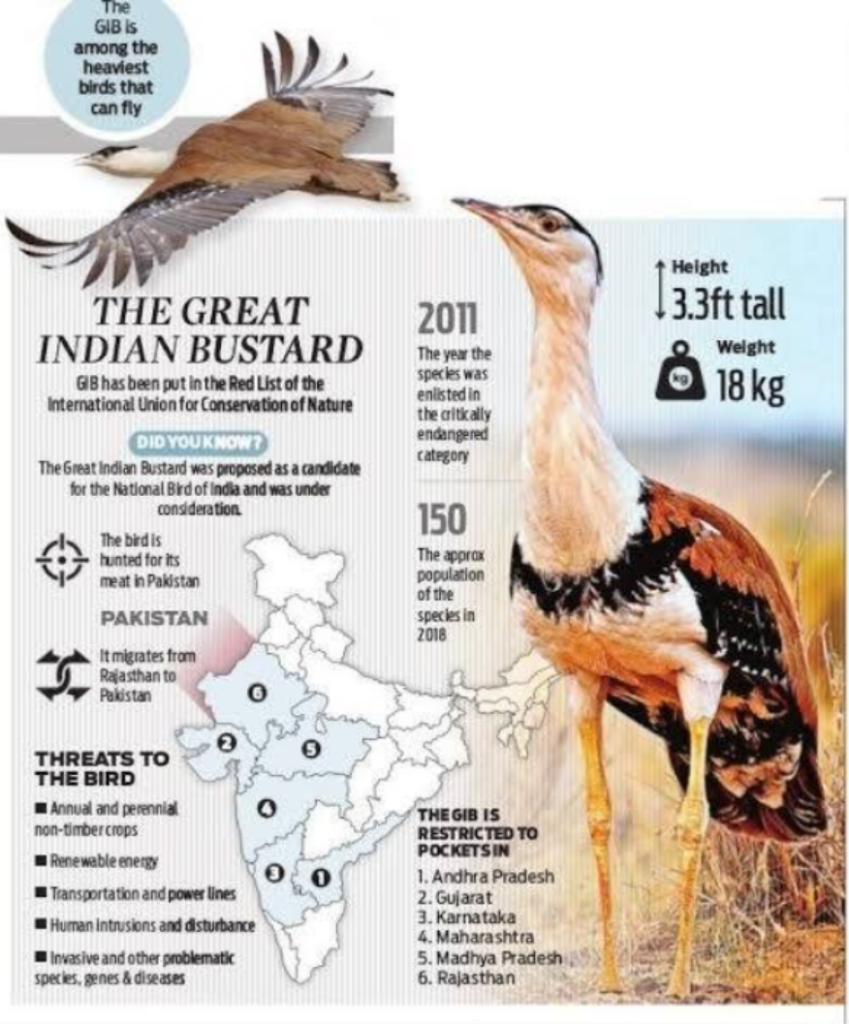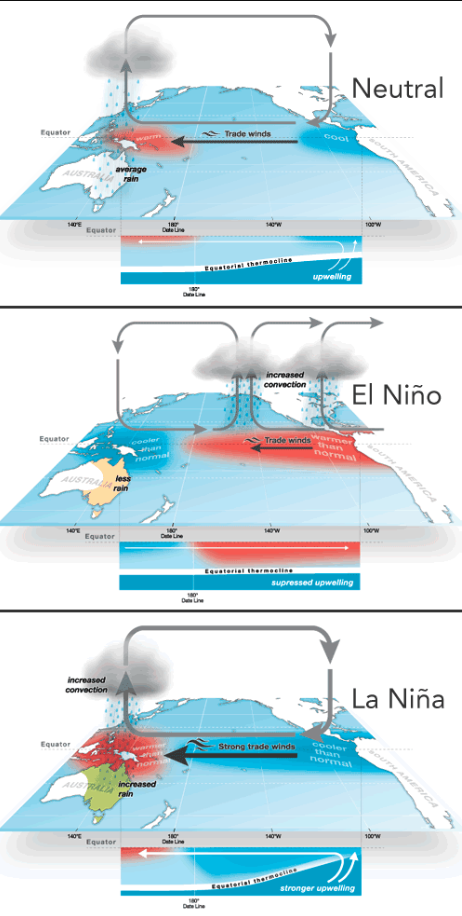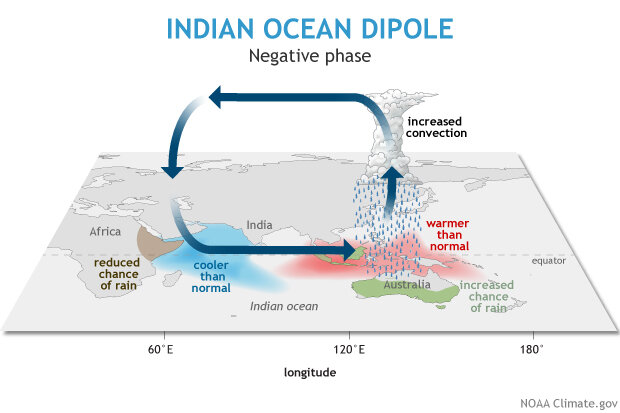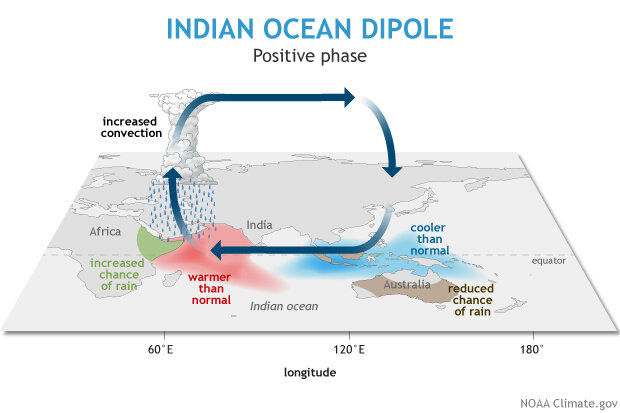CONTENTS
- The Great Indian Bustard and Climate Action Verdict
- Monsoon Prediction in India
The Great Indian Bustard and Climate Action Verdict
Context:
In a recent ruling, the Supreme Court of India has acknowledged the existence of a fundamental entitlement to freedom from the adverse effects of climate change (referred to as ‘the right’ hereafter). The decision has drawn considerable attention from environmentalists, primarily focusing on its implications for safeguarding the Great Indian Bustard. This article takes a broader perspective, examining the ruling through the lens of inclusive climate action.
Relevance:
GS3- Environment- Conservation
Mains Question:
Merely recognizing right to be free from the adverse effects of climate change without articulating it raises concerns on the efficacy of the ruling. Analyse in the context of the Supreme Court’s judgement in the conservation of the Great Indian Bustard. (15 Marks, 250 Words).
Analysing the Implications of the Ruling:
- Firstly, by simply acknowledging the right without delving into its specifics, the Court has paved the way for meaningful discussions on its scope and implications. This could lead to a more nuanced understanding of the right in the future.
- Secondly, considering the central issue at hand, adopting the just transition framework is a commendable step forward. It has the potential to promote fair climate action, including the development of a more reflective and inclusive interpretation of the right.
- The entitlement referred to as “The Right” pertains to the critical habitat shared by the endangered Great Indian Bustard across the States of Rajasthan and Gujarat, alongside their significant potential for solar and wind energy development.
Evolution of the Supreme Court’s Judgements in this Regard:
2019:
Petitioner’s Arguments:
- In 2019, concerned citizens (petitioners) initiated a public interest litigation seeking the conservation of the bustard.
- They concurrently requested an injunction to halt the construction of additional solar and wind energy infrastructure and the installation of overhead power transmission lines associated with them.
- Their argument centered on the danger posed by these power lines, leading to frequent collisions and fatalities among the bustards.
Supreme Court’s Ruling:
- In its ruling, the Supreme Court imposed a blanket ban on the installation of overhead power lines within an extensive area of 99,000 square kilometers, encompassing regions designated as priority and potential conservation areas for the bustard.
- Additionally, the Court mandated the undergrounding of existing power lines, spanning both high and low voltage.
Government’s Argument:
- The government contested this decision, citing India’s international commitments to transitioning away from fossil fuels and mitigating carbon emissions.
- It contended that the blanket ban encompassed a much larger area than the actual habitat of the bustard, which also happened to host a substantial portion of the nation’s wind and solar energy potential.
- Furthermore, it argued that undergrounding power lines was impractical, and it attributed the decline in the bustard population to factors beyond power lines, including poaching, habitat destruction, and predation.

2024:
Committee Established:
- In its ruling dated March 21, 2024, the Court amended its previous directive, rescinding the blanket ban on transmission lines. Instead, it delegated the revision of the order to scientific experts.
- To this end, it established an expert committee tasked with, among other things, evaluating the feasibility of underground power lines and devising measures for bustard conservation.
- The committee is required to submit its findings by July 2024, after which the Court will issue its final judgment.
Court’s Move:
- In a groundbreaking move, the Court seized this opportunity to acknowledge the existence of a right to protection against the detrimental effects of climate change.
- It observed that this right is implicit in the right to equality (Article 14) and the right to life (Article 21) enshrined in the Indian Constitution.
- The Court commenced by elucidating the threat posed by climate change impacts to the enjoyment of the right to life.
- It then underscored how disproportionate vulnerability to these impacts undermines the affected individuals’ right to equality.
- Concluding this discourse, the Court determined that the foundation of the right lies in a comprehensive examination of judicial precedents on Articles 21 and 14, India’s climate change initiatives and international commitments, and the scientific consensus on the adverse effects of climate change.
Recognising the Right but not Articulating it:
- The Court acknowledged the existence of the right but refrained from elaborating on it further. Moreover, it emphasized the necessity of articulation while abstaining from taking on that responsibility.
- This deliberate decision not to articulate the right, only recognizing it, deviates from the Court’s typical approach in environmental cases.
- Much of Indian environmental law has evolved through the Court’s adjudication in public interest litigation, where it has introduced, acknowledged, and specified environmental rights and legal principles.
- While lauded for its proactive stance, this practice has been criticized for judicial overreach and the formulation of ambiguous rights.
- In contrast, in this instance, the Court adopted a restrained approach. This may be deemed as an appropriate strategy at this initial stage of recognizing the right, as it stimulates discourse on climate rights while allowing room for the development of a more well-informed right.
- However, it’s important to note that the Court’s acknowledgment of the right does not feature in the operative part of the judgment, making it non-binding in itself. Although it is likely to influence future climate action, its actual impact remains uncertain.
Other Aspects of the Judgement:
- The primary concern revolved around mitigating the adverse effects of renewable energy initiatives on the bustard population.
- Conservationist Debadityo Sinha aptly pointed out that the judgment approached this issue as a dilemma between two conflicting options: preserving biodiversity or pursuing climate action measures. Essentially, it framed biodiversity conservation and climate action as opposing choices.
- Moreover, the acknowledgment of the right was framed within this dichotomy, juxtaposing biodiversity protection against climate action.
- Consequently, the recognized right pertained solely to safeguarding human interests from climate change impacts.
Way Forward:
- To avoid this dilemma in the future, an alternative approach could be employed: the adoption of the just transition framework. This framework, currently utilized in climate-related cases globally, aims to ensure that transitions to a low-carbon economy are fair and inclusive.
- It particularly prioritizes the needs of those most affected by such transitions, including workers, vulnerable communities, and small to medium-sized enterprises.
- When confronted with issues similar to those in the present case, employing the just transition framework proves to be a beneficial approach.
- It allows for the protection of marginalized interests, such as those of the bustard, which are threatened by slow carbon transition projects, like solar energy initiatives in this instance.
- This approach offers several advantages. Firstly, it avoids framing climate action and biodiversity protection as conflicting options and instead promotes inclusive climate action, which takes into account various rights and interests.
- Secondly, it facilitates the development of more reflective and inclusive climate rights. By incorporating this approach into climate litigation, it ensures that the articulation and enforcement of climate rights consider the interests of the non-human world and promote ecological justice.
- Thirdly, if the framework is applied in the final court decision, this case would be among the first just transition litigations to address non-human interests. Globally, only one other case in existing just transition litigations concerns the protection of non-human environmental interests, making this case a pioneer in such litigation. In theory, it contributes to broadening the concept of a just transition to encompass considerations beyond human interests.
Conclusion:
Thus the above situation presents a valuable space for initiating discussions on the substance of this right—a chance to ensure it is inclusive and effective. However, this responsibility is not solely on the state; it’s a shared burden. It extends to activists, litigants, and academics, who contribute to defining rights through their participation, whether indirectly or directly, in the process of recognition, articulation, and enforcement.
Monsoon Prediction in India
Context:
The India Meteorological Department (IMD) has predicted a plentiful monsoon season. The forecast indicates that rainfall from June to September is anticipated to exceed the average of 87 cm, with an expected increase of 6%. This is a notably assertive prediction from the agency, which typically refrains from indicating either surplus or deficit rainfall in its April forecasts. While this news may be welcomed, particularly in light of soaring temperatures and heatwaves in many southern states, there is a caveat to this optimistic outlook.
Relevance:
GS1- Geography- Important Geophysical Phenomena
Mains Question:
According to the IMD’s climate models, there is a 30% probability of “excessive” rainfall in India. In this context, explain the variation in the rainfall pattern in India with the El Niño-Southern Oscillation (ENSO) cycle and Indian Ocean Dipole. (10 Marks, 150 Words).
More on the Prediction:
- According to the IMD’s climate models, there is a 30% probability of “excessive” rainfall, defined as surpassing 10% of the normal rainfall amount.
- In comparison, the expectation of “above-normal” rainfall stands at 31%, defined as falling between 5% to 10% above normal levels.
- This slight difference suggests that the likelihood of excessive rainfall is nearly as high as that of merely above-normal showers.
- The majority of these heavy rains are anticipated in the latter half of the monsoon season, specifically in August and September.
Basis of this Prediction by IMD:
- The IMD’s models predict these conditions based on the emergence of a La Niña phenomenon, which is the opposite of El Niño and often leads to a reduction in monsoon rainfall.
- Additionally, La Niña is expected to be influenced by a positive Indian Ocean Dipole, characterized by cooler-than-normal temperatures in the eastern Indian Ocean compared to the western region, which typically brings rainfall to several states in southern India.
El-Nino and La-Nina:
- El Niño and La Niña are intricate weather phenomena arising from fluctuations in ocean temperatures in the Equatorial Pacific Region.
- They represent opposing phases within the El Niño-Southern Oscillation (ENSO) cycle, which characterizes temperature changes between the ocean and atmosphere in the east-central Equatorial Pacific.
- El Niño and La Niña events typically persist for nine to 12 months, though some prolonged occurrences may extend over several years.
- El Niño refers to a climate pattern marked by abnormal warming of surface waters in the eastern tropical Pacific Ocean, representing the “warm phase” of the ENSO cycle. It occurs more frequently compared to La Niña.
- On the other hand, La Niña, the “cool phase” of ENSO, entails unusual cooling of the tropical eastern Pacific. La Niña events can endure from one to three years, unlike El Niño, which typically lasts for no more than a year. Both phenomena often reach their peak during the Northern Hemisphere winter.

Indian Ocean Dipole (IOD):
- The Indian Ocean Dipole, also known as the Indian Nino, resembles the El Nino phenomenon but occurs within the Indian Ocean, spanning the area between the Indonesian and Malaysian coastlines in the east and the African coastline near Somalia in the west.
- El Nino, a component of the El Nino Southern Oscillation (ENSO), denotes a phase of warmer-than-normal temperatures and reduced rainfall in various regions worldwide, including India.
- During El Nino, one side of the ocean along the equator experiences higher temperatures than the other.
Positive and Negative Phases:
IOD is categorized as positive when the western side of the Indian Ocean near the Somalia coast becomes warmer than the eastern Indian Ocean, and negative when the western Indian Ocean is cooler.
Negative IOD:
- Under negative IOD conditions, air circulation within the Indian Ocean basin shifts from west to east near the surface, and conversely at higher levels.
- Typically, warmer waters from the western Pacific near Indonesia flow into the Indian Ocean, slightly warming that region. This warming leads to upward air movement, reinforcing prevailing circulation patterns.
- During negative IOD years, intensified air circulation pushes more warm surface waters from the African coast towards the Indonesian islands, resulting in an even warmer Indonesian region.

Positive IOD:
- During positive IOD events, air circulation weakens, and in rare instances, even reverses. Consequently, the African coast experiences higher temperatures while the Indonesian coastline cools.
- Positive IOD events often coincide with El Nino occurrences, while negative IOD events are sometimes linked with La Nina.
- El Nino’s influence causes cooling on the Pacific side of Indonesia, which in turn contributes to the development of a positive IOD in the Indian Ocean.
- While the IMD does not specify the quantity of rainfall expected in June and July, it anticipates “neutral conditions” during that period, with neither El Niño nor La Niña prevailing.
- Although two dry months followed by heavy rains in the last two months may benefit agriculture, it could also result in severe floods and, as seen in the past, substantial damage to lives, livelihoods, and infrastructure.

Susceptibility to Natural Disasters:
- States should promptly develop emergency plans based on their disaster management frameworks to enhance infrastructure, establish evacuation protocols, conduct assessments of dam structural integrity and distress signaling systems, and ensure the availability of comprehensive early warning networks.
- Additionally, it is imperative to inform India’s predominantly rain-fed agriculture-dependent farmers about the potential for a more intense second half of the monsoon and encourage them to incorporate this information into their planting strategies.
Conclusion:
The devastating floods experienced in Kerala in 2018 serve as a stark reminder of India’s susceptibility to natural disasters. While an updated forecast is anticipated towards the end of May, it is crucial to heed the current signal provided by the IMD without delay.




